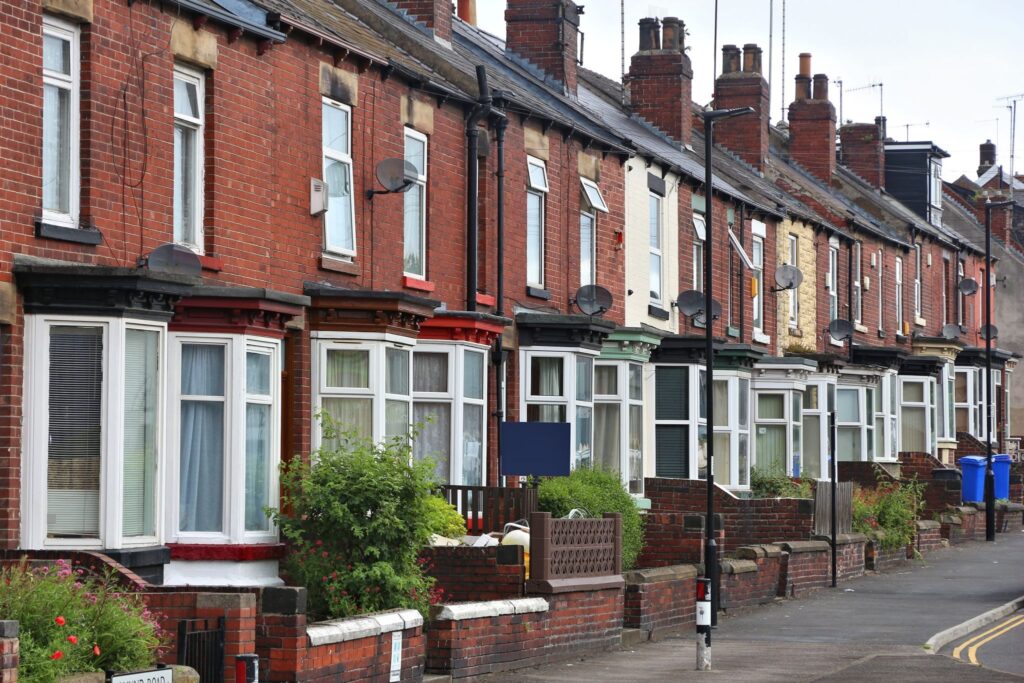

A guide to HMOs: Are they a good choice for property investors?
Houses in multiple occupation (HMOs) are becoming an increasingly popular investment option in the UK.
In recent years, buy-to-let landlords have seen a surge in tenant demand that is only expected to increase further over the coming years. This is down to factors including changing lifestyle preferences towards more flexible living arrangements, along with high house prices meaning people are renting for longer.
An increase in the number of houses in multiple occupation (HMOs) has been one outcome of this growth in demand, particularly among young professionals. HMOs not only offer a more sociable and often cheaper option for tenants, but they can also be a particularly high-yielding asset class for landlords.
What is an HMO?
Where a rental property is occupied by three or more people forming more than one ‘household’ (a household being a single person or members of the same family), with shared toilet, bathroom or kitchen facilities, this is classed as a house in multiple occupation, or an HMO.
A ‘large HMO’ is where there are five or more occupants forming more than one household with shared facilities. Large HMOs, as well as certain regular HMOs, need a licence from the local council to operate, and must comply with certain other regulations.
Array
(
[ID] => 6090737
[id] => 6090737
[title] => townhouses-HMO-1024x768
[filename] => townhouses-HMO-1024x768-1.jpeg
[filesize] => 199388
[url] => https://www.buyassociationgroup.com/en-gb/wp-content/uploads/sites/2/2022/11/townhouses-HMO-1024x768-1.jpeg
[link] => https://www.buyassociationgroup.com/en-gb/investments/townhouses-hmo-1024x768/
[alt] =>
[author] => 4195
[description] =>
[caption] =>
[name] => townhouses-hmo-1024x768
[status] => inherit
[uploaded_to] => 6
[date] => 2022-11-21 12:38:09
[modified] => 2022-11-21 12:38:09
[menu_order] => 0
[mime_type] => image/jpeg
[type] => image
[subtype] => jpeg
[icon] => https://www.buyassociationgroup.com/en-gb/wp-includes/images/media/default.png
[width] => 1024
[height] => 768
[sizes] => Array
(
[thumbnail] => https://www.buyassociationgroup.com/en-gb/wp-content/uploads/sites/2/2022/11/townhouses-HMO-1024x768-1-150x150.jpeg
[thumbnail-width] => 150
[thumbnail-height] => 150
[medium] => https://www.buyassociationgroup.com/en-gb/wp-content/uploads/sites/2/2022/11/townhouses-HMO-1024x768-1-300x225.jpeg
[medium-width] => 300
[medium-height] => 225
[medium_large] => https://www.buyassociationgroup.com/en-gb/wp-content/uploads/sites/2/2022/11/townhouses-HMO-1024x768-1-768x576.jpeg
[medium_large-width] => 768
[medium_large-height] => 576
[large] => https://www.buyassociationgroup.com/en-gb/wp-content/uploads/sites/2/2022/11/townhouses-HMO-1024x768-1.jpeg
[large-width] => 1024
[large-height] => 768
[1536x1536] => https://www.buyassociationgroup.com/en-gb/wp-content/uploads/sites/2/2022/11/townhouses-HMO-1024x768-1.jpeg
[1536x1536-width] => 1024
[1536x1536-height] => 768
[2048x2048] => https://www.buyassociationgroup.com/en-gb/wp-content/uploads/sites/2/2022/11/townhouses-HMO-1024x768-1.jpeg
[2048x2048-width] => 1024
[2048x2048-height] => 768
[post-thumbnail] => https://www.buyassociationgroup.com/en-gb/wp-content/uploads/sites/2/2022/11/townhouses-HMO-1024x768-1-125x125.jpeg
[post-thumbnail-width] => 125
[post-thumbnail-height] => 125
[landscape_600x400] => https://www.buyassociationgroup.com/en-gb/wp-content/uploads/sites/2/2022/11/townhouses-HMO-1024x768-1-600x400.jpeg
[landscape_600x400-width] => 600
[landscape_600x400-height] => 400
[landscape_500x300] => https://www.buyassociationgroup.com/en-gb/wp-content/uploads/sites/2/2022/11/townhouses-HMO-1024x768-1-500x300.jpeg
[landscape_500x300-width] => 500
[landscape_500x300-height] => 300
[landscape_750x350] => https://www.buyassociationgroup.com/en-gb/wp-content/uploads/sites/2/2022/11/townhouses-HMO-1024x768-1-750x350.jpeg
[landscape_750x350-width] => 750
[landscape_750x350-height] => 350
)
)

Why choose an HMO?
Growing demand: As previously mentioned, tenant demand is high and isn’t slowing down any time soon, as a rising number of people are renting until later in life. Multi-let properties (including HMOs) are hugely popular with the 25-34-year-old demographic, which makes up almost a third of tenants.
Landlords who let their properties to students are also seeing a significant rise in demand across major university towns and cities. This has led to growth in the student HMO market, which again can offer high yields and excellent occupancy rates year after year. University towns and cities are also a great target for property investors looking to accommodate young professionals.
Array
(
[ID] => 6037527
[id] => 6037527
[title] => hmo homes in a row
[filename] => shutterstock_1627749904-min-scaled-1.jpg
[filesize] => 631046
[url] => https://www.buyassociationgroup.com/en-gb/wp-content/uploads/sites/2/2021/11/shutterstock_1627749904-min-scaled-1.jpg
[link] => https://www.buyassociationgroup.com/en-gb/about-us/shutterstock_1627749904-min/
[alt] => HMOs homes buy-to-let high yields
[author] => 1
[description] =>
[caption] =>
[name] => shutterstock_1627749904-min
[status] => inherit
[uploaded_to] => 5491
[date] => 2021-11-19 13:55:05
[modified] => 2024-03-10 20:14:24
[menu_order] => 0
[mime_type] => image/jpeg
[type] => image
[subtype] => jpeg
[icon] => https://www.buyassociationgroup.com/en-gb/wp-includes/images/media/default.png
[width] => 2048
[height] => 1365
[sizes] => Array
(
[thumbnail] => https://www.buyassociationgroup.com/en-gb/wp-content/uploads/sites/2/2021/11/shutterstock_1627749904-min-scaled-1-150x150.jpg
[thumbnail-width] => 150
[thumbnail-height] => 150
[medium] => https://www.buyassociationgroup.com/en-gb/wp-content/uploads/sites/2/2021/11/shutterstock_1627749904-min-scaled-1-300x200.jpg
[medium-width] => 300
[medium-height] => 200
[medium_large] => https://www.buyassociationgroup.com/en-gb/wp-content/uploads/sites/2/2021/11/shutterstock_1627749904-min-scaled-1-768x512.jpg
[medium_large-width] => 768
[medium_large-height] => 512
[large] => https://www.buyassociationgroup.com/en-gb/wp-content/uploads/sites/2/2021/11/shutterstock_1627749904-min-scaled-1-1024x683.jpg
[large-width] => 1024
[large-height] => 683
[1536x1536] => https://www.buyassociationgroup.com/en-gb/wp-content/uploads/sites/2/2021/11/shutterstock_1627749904-min-scaled-1-1536x1024.jpg
[1536x1536-width] => 1536
[1536x1536-height] => 1024
[2048x2048] => https://www.buyassociationgroup.com/en-gb/wp-content/uploads/sites/2/2021/11/shutterstock_1627749904-min-scaled-1.jpg
[2048x2048-width] => 2048
[2048x2048-height] => 1365
[post-thumbnail] => https://www.buyassociationgroup.com/en-gb/wp-content/uploads/sites/2/2021/11/shutterstock_1627749904-min-scaled-1.jpg
[post-thumbnail-width] => 125
[post-thumbnail-height] => 83
[landscape_600x400] => https://www.buyassociationgroup.com/en-gb/wp-content/uploads/sites/2/2021/11/shutterstock_1627749904-min-scaled-1-600x400.jpg
[landscape_600x400-width] => 600
[landscape_600x400-height] => 400
[landscape_500x300] => https://www.buyassociationgroup.com/en-gb/wp-content/uploads/sites/2/2021/11/shutterstock_1627749904-min-scaled-1-500x300.jpg
[landscape_500x300-width] => 500
[landscape_500x300-height] => 300
[landscape_750x350] => https://www.buyassociationgroup.com/en-gb/wp-content/uploads/sites/2/2021/11/shutterstock_1627749904-min-scaled-1-750x350.jpg
[landscape_750x350-width] => 750
[landscape_750x350-height] => 350
)
)

Higher yields: HMOs have the potential to generate stronger yields for property investors than a traditional rental home being let to one household. This is because each room in an HMO is normally rented out individually to either a single person or a couple, rather than charging a price for the whole property, and this can bring in a higher level of rent overall.
Less impact from voids: For the same reason, you are less likely to face significant void periods where you have no rental income. If one tenant leaves, the other tenants continue to pay rent until a replacement is found. Void periods are something all landlords must factor in when calculating their costs, but the risk is offset in an HMO.
In the unlikely but unfortunate event that you have a tenant who refuses to pay, you will still receive the income from the rest of the HMO to minimise the impact.
Important considerations
Licensing: As mentioned above, some HMOs and all large HMOs need a licence, which can be obtained from the local council. Landlords with HMOs must find out whether they fall under selective or additional licensing rules, as failure to comply will lead to penalties.
Management: While an upside of owning an HMO can mean less void periods of a whole property, having separate contracts for each tenant can be more time-consuming than having one contract per property, as tenancies may start and end at different times meaning more time spent seeking occupiers. Some landlords will enlist management companies to deal with this side of things for them, and some HMO opportunities are offered as a fully managed/hands-off investment. It is up to the investor to decide what would suit them best.
Bedroom sizes: Properties must have minimum bedroom sizes (for those that where licensed on or after 1 October 2018, or anyone renewing a licence since then). Bedrooms in an HMO must be at least 6.51 square metres for an adult, 10.22 square metres for two adults, and 4.64 square metres for children under 10. Councils have the right to impose higher minimum room sizes if they see fit.
This means that not every property can be run as an HMO, where room sizes do not meet these requirements. Instead, a property with bedrooms smaller than these requirements can be run as a traditional buy-to-let, with one tenancy agreement for the whole home.

GET IN TOUCH
Join over 30,000 property investors
Access advice and unique property investment opportunities directly from leading developers throughout the UK
Array
(
[ID] => 6089585
[id] => 6089585
[title] => planning savings money of coins to buy a home, concept for property ladder, mortgage and real estate investment. for saving or investment for a house, growing business
[filename] => cash-buyer-money-property-scaled-1.webp
[filesize] => 111588
[url] => https://www.buyassociationgroup.com/en-gb/wp-content/uploads/sites/2/2022/11/cash-buyer-money-property-scaled-1.webp
[link] => https://www.buyassociationgroup.com/en-gb/advice/planning-savings-money-of-coins-to-buy-a-home-concept-for-property-ladder-mortgage-and-real-estate-investment-for-saving-or-investment-for-a-house-growing-business/
[alt] => Cash buyers property
[author] => 1069
[description] =>
[caption] => planning savings money of coins to buy a home, concept for property ladder, mortgage and real estate investment. for saving or investment for a house, growing business
[name] => planning-savings-money-of-coins-to-buy-a-home-concept-for-property-ladder-mortgage-and-real-estate-investment-for-saving-or-investment-for-a-house-growing-business
[status] => inherit
[uploaded_to] => 8417
[date] => 2022-11-03 14:02:12
[modified] => 2022-11-24 10:12:58
[menu_order] => 0
[mime_type] => image/webp
[type] => image
[subtype] => webp
[icon] => https://www.buyassociationgroup.com/en-gb/wp-includes/images/media/default.png
[width] => 2048
[height] => 1365
[sizes] => Array
(
[thumbnail] => https://www.buyassociationgroup.com/en-gb/wp-content/uploads/sites/2/2022/11/cash-buyer-money-property-scaled-1-150x150.webp
[thumbnail-width] => 150
[thumbnail-height] => 150
[medium] => https://www.buyassociationgroup.com/en-gb/wp-content/uploads/sites/2/2022/11/cash-buyer-money-property-scaled-1-300x200.webp
[medium-width] => 300
[medium-height] => 200
[medium_large] => https://www.buyassociationgroup.com/en-gb/wp-content/uploads/sites/2/2022/11/cash-buyer-money-property-scaled-1-768x512.webp
[medium_large-width] => 768
[medium_large-height] => 512
[large] => https://www.buyassociationgroup.com/en-gb/wp-content/uploads/sites/2/2022/11/cash-buyer-money-property-scaled-1-1024x683.webp
[large-width] => 1024
[large-height] => 683
[1536x1536] => https://www.buyassociationgroup.com/en-gb/wp-content/uploads/sites/2/2022/11/cash-buyer-money-property-scaled-1-1536x1024.webp
[1536x1536-width] => 1536
[1536x1536-height] => 1024
[2048x2048] => https://www.buyassociationgroup.com/en-gb/wp-content/uploads/sites/2/2022/11/cash-buyer-money-property-scaled-1.webp
[2048x2048-width] => 2048
[2048x2048-height] => 1365
[post-thumbnail] => https://www.buyassociationgroup.com/en-gb/wp-content/uploads/sites/2/2022/11/cash-buyer-money-property-scaled-1.webp
[post-thumbnail-width] => 125
[post-thumbnail-height] => 83
[landscape_600x400] => https://www.buyassociationgroup.com/en-gb/wp-content/uploads/sites/2/2022/11/cash-buyer-money-property-scaled-1-600x400.webp
[landscape_600x400-width] => 600
[landscape_600x400-height] => 400
[landscape_500x300] => https://www.buyassociationgroup.com/en-gb/wp-content/uploads/sites/2/2022/11/cash-buyer-money-property-scaled-1-500x300.webp
[landscape_500x300-width] => 500
[landscape_500x300-height] => 300
[landscape_750x350] => https://www.buyassociationgroup.com/en-gb/wp-content/uploads/sites/2/2022/11/cash-buyer-money-property-scaled-1-750x350.webp
[landscape_750x350-width] => 750
[landscape_750x350-height] => 350
)
)

How to invest in an HMO
Like with any successful property investment, market knowledge can go a long way when selecting the best HMO investment. The location of the property can determine your returns, as well as taking into account the initial costs, potential capital gains as well as tenant demand and rental yields in the area.
While London is always going to in high demand, house prices and running costs are also at the top end – sometimes prohibitively so. This is why considering regional locations such as Manchester, Birmingham and Liverpool, as well as smaller towns and cities, can often generate the strongest returns over time.
At BuyAssociation, we work with a number of specialist developers with a proven track record for offering fantastic HMO opportunities, as well as tailored property management options for investors. If you’d like more information, get in touch with BuyAssociation today.




